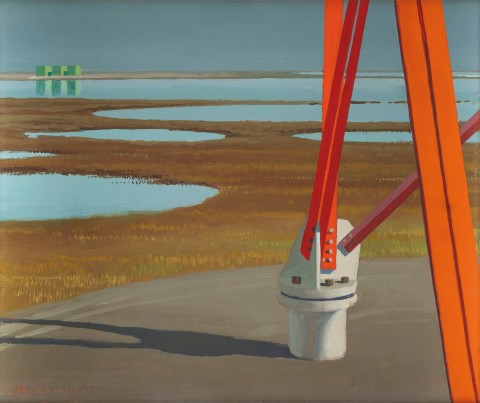SECOND STUDY FOR PRUDHOE BAY LANDSCAPE, 1974
JEFFREY SMART
oil on canvas board
30.5 x 36.0 cm
signed lower left: JEFFREY SMART
Frank Rickwood OBE, Barbados, a gift from the artist in 1974
Private collection, a gift from the above
Savill Galleries, Sydney (label attached verso, as ‘Prudhole [sic.] Landscape’)
Private collection, Sydney, acquired in 2009
Smart, J., Not Quite Straight: A Memoir, William Heinemann, Melbourne, 1996, pp. 436-440
Prudhoe Bay Landscape, 1974, in Quartermaine, P., Jeffrey Smart, Gryphon Books, Melbourne, 1983, p 113, cat. 635, commissioned for British Petroleum International Collection, by Mr Frank Rickwood OBE
First Study for Prudhoe Landscape, 1974, oil on canvas board, 41.0 x 30.5 cm, formerly in the collection of Frank Rickwood OBE, Barbados
We are grateful to Stephen Rogers, Archivist for the Estate of Jeffrey Smart, for his assistance with this catalogue entry.
Jeffrey Smart met Frank Rickwood in 1951, while the artist was living at ‘Fairlight’, a boarding house in Elizabeth Bay, with artists Michael Shannon and Justin O’Brien. At the time, Rickwood was a lecturer in Geology at the University of Sydney, soon to become an advisor for Oil Search responsible for major discoveries in New Guinea, and later in Venezuela. By 1956 he had joined BP, working in New York and England before moving to San Francisco, and from 1969 – 1980 he was President of BP Alaska, overseeing the expansion of the Prudhoe Bay project, the largest oil field in North America where the new, ground-breaking Alaskan pipeline was being developed.
After declining a previous offer from his old friend to travel to Alaska to make paintings of the major works at Prudhoe Bay, Smart reconsidered when ‘Rickwood wrote from San Francisco, upping his offer for pictures of the Alaska project, and offering to fly me to San Francisco and the North Slope, first class all the way. It was irresistible and I decided to go.’1
Smart was very impressed with the amazing facility, named ‘Dead Horse’, built to accommodate VIPs and important heads of drilling activities. It was erected upon the permafrost in conditions where the outside temperature could reach minus 40 degrees celsius. ‘It was an engineering triumph… streamlined, like a space missile so that it could survive the fantastic winds of a blizzard. It sat on pylons, and I could not understand how the enormous weight of Dead Horse did not cause the ice to melt and sink down into the permafrost.’2
Smart described entering Dead Horse like going into a submarine, through a chamber before reaching the interior with forty comfortable bedrooms with bathroom, a huge swimming pool, a theatre, gymnasium, a winter garden with (tropical) trees. His residency there resulted in two large paintings and at least three known studies, of which Second Study for Prudhoe Bay Landscape, 1974 is one. The two larger paintings became property of British Petroleum International Collection, while the studies were gifts from the artist to Frank Rickwood who, as the artist noted, ‘…I know he gave away some of the little studies as presents to friends. This ‘Prudhoe Bay’ must be one of them.’3
Smart’s fascination with the architecture of Dead Horse, became the basis of the picture on offer, as the artist evokes a space-age like scene depicting the bright red steel girders and concrete footing of the (unseen) structure elevated above. Standing upon a vast, flat landscape, the wilderness is again interrupted by the presence of three Nissen huts, in this case where the oil company workers lived, but also symbolically the sign of human occupation and development. Painted only five years on from the lunar landing in 1969, this powerful picture, featuring Jeffrey Smart’s quintessential symbolism, illustrates the artist’s continuing interest in the patterns of human interaction with our surroundings: ‘Dead Horse was a great piece of architecture, a triumph of man over his environment.’4
1. Smart, J., Not Quite Straight: A Memoir, William Heinemann Australia, Melbourne, 1996, p. 434
2. Ibid., p. 438
3. The artist in correspondence with Stephen Rogers, Archivist for the Estate of Jeffrey Smart, 16 July 1998
4. Smart, op. cit., p. 438
DAMIAN HACKETT
